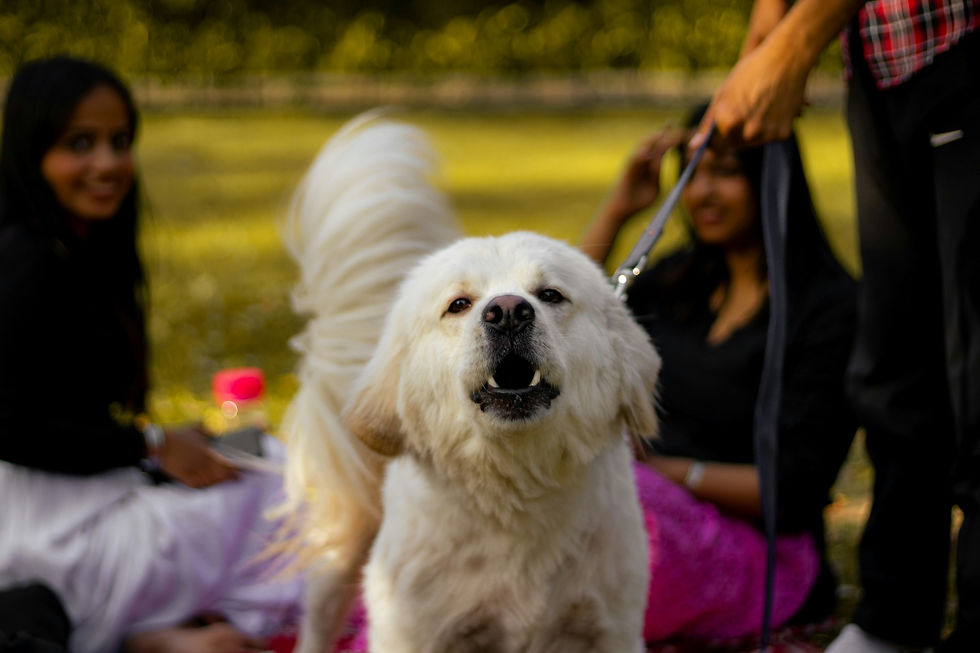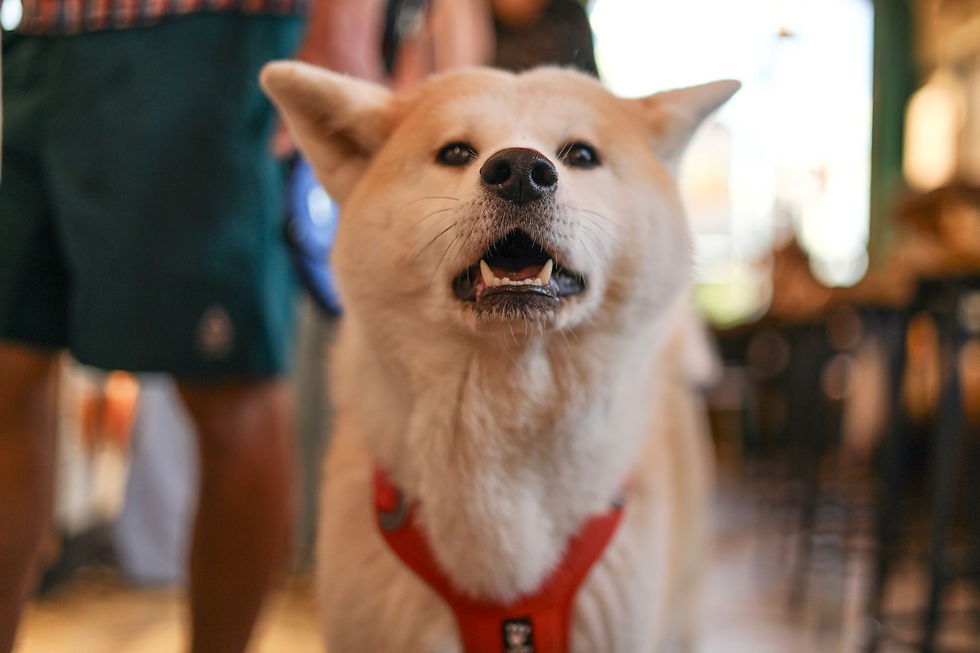Reactive vs Aggressive Dog: What’s the Difference?
- Molly Weinfurter
- Aug 21
- 6 min read
A lot of people use the terms “reactive” and “aggressive” interchangeably. I know I used to when I was younger. Yet, after meeting a wide variety of dogs through work and volunteering, including reactive and aggressive ones, I’ve learned that those two words are more different than most people think. While some dogs can be both, many dogs are reactive without aggression. So, when it comes to reactive vs aggressive dogs, what’s the difference?
What is a Reactive Dog?
Cornell University describes a reactive dog as “one who overreacts to normal situations that other dogs would take in stride.” This typically includes barking, growling, lunging, or becoming hyper focused on animals and/or people. While these behaviors can lead to aggression in certain dogs, some dogs only act out and never cause harm.

What Causes Reactivity in Dogs?
Reactivity in dogs is usually caused by fear or stress. They become overstimulated in certain scenarios, causing them to act out in a way that’s difficult for their human to control. This fear can stem from many reasons, such as past trauma, poor socialization, or genetics. Consistently working on training and socialization with your dog is the best way to prevent or reduce reactive behaviors.
How to Socialize a Reactive Dog
Dog socialization typically begins when the dog is a young puppy. Gradually introducing them to new sights, sounds, people, and pets in positive, controlled environments can help dogs feel confident as they get older. However, if a puppy comes from an irresponsible breeder or if a rescue dog has an abusive past, they may already have some reactivity when you bring them home.
If your dog is already reactive, walks can be stressful for both of you. Rather than forcing your dog to overcome their fears, take things slow. First, figure out what your dog’s trigger is, whether it’s people, other dogs, or new environments. Then, very gradually, expose your dog to that trigger in positive ways, such as rewarding your dog with treats when they see a dog in the distance.
It’s important to have patience with all types of dog training, but it’s especially important for reactive dogs. If you’re struggling to make progress with your pup, I’d recommend consulting a trainer. Trainers that have experience with reactive dogs can give you personalized training tips to set your dog up for success.
What is an Aggressive Dog?
The ASPCA defines dog aggression as “a range of behaviors that usually begins with warnings and can culminate in an attack.” Aggressive dogs are reactive, but their behaviors can escalate to threatening actions and harm. While their behaviors might start with barking, lunging, and growling, they often include other actions, such as:
Stiff body
Showing teeth
Snapping
Nipping
Biting
Grabbing and shaking
Usually, aggressive dogs start with small warning signs before leading up to harmful behaviors, but every dog is different. Some dogs escalate their behaviors quickly while others take a while to show the above actions.

What Causes Aggression in Dogs?
While reactivity is typically fear-based, aggression can stem from lots of things. It could come from fear, stress, past trauma, learned behaviors, pain, instincts, and genetics. So, some aggressive dogs are scared or stressed, but others are protective, territorial, defensive, frustrated, or predatory. What caused the aggression greatly influences how your dog behaves.
For example, dogs with territorial instincts may be more likely to act aggressively around their home or personal belongings. Dogs who were previously attacked by other dogs are more likely to be aggressive toward other pets. A dog with a high prey drive may chase down people and animals while showing aggression. Understanding your dog is an important part of reducing their aggression.
Can Dog Aggression Be Fixed?
It depends on the dog. In most cases, dog aggression can be reduced or controlled with the right training tools, but it’s a lot of work. You need to be patient and dedicated to your dog’s progress. Most dogs aren’t aggressive all the time, so you need to figure out what triggers your dog’s aggression to help you get to the root of the problem.
The best way to reduce aggression in dogs is to work with a trainer. I know dog trainers can be pricey, but they have experience with all kinds of behavior problems in dogs. They can help you determine the best way to handle your dog’s actions to help make life easier for both you and your dog.
How to Train an Aggressive Dog
Once you know an aggressive dog’s trigger, you can work toward helping them associate that trigger with something positive. Gradually expose them to the trigger and work on redirecting them when they start to show reactivity. Reward them for redirecting their attention instead of lashing out.
It’s best to work on training in a controlled, comfortable environment. If you start on a busy street, you’re only putting your dog and those around them at risk. Training an aggressive dog is a lot more tedious than training the average dog, so go as slow as possible and reward your dog for any progress, no matter how small.
Aggressive dogs should work with a dog trainer at some point in their training process. Their behaviors could put people and animals in danger, so consulting a professional is the best way to avoid any harmful situations. Plus, the trainer may have some special training techniques that cater to your dog’s unique personality and actions.

Reactive vs Aggressive Dog: Key Differences
All aggressive dogs are reactive, but not all reactive dogs are aggressive. Intent is the key difference for an aggressive vs reactive dog. Reactive dogs are typically acting out of fear and don’t intend to cause harm while aggressive dogs try to cause harm. Dogs that are only reactive could end up becoming aggressive if they’re not carefully desensitized to their trigger.
Both reactive and aggressive dogs should be handled with care. They both require patient, repetitive training, ideally with the help of a professional trainer. Caring for these dogs is no easy task, but many dogs can improve with the right training and socialization plan in place. These dogs may never be overly friendly and outgoing, but many can make great progress if you’re willing to work with them.
Frequently Asked Questions
Are Certain Breeds More Likely to Be Reactive?
Dogs bred with a specific purpose, such as herding dogs and hunting dogs, are often more likely to be reactive. This is because they require a lot of exercise, mental stimulation, and socialization, so if they’re not getting that, they may act out as a result. However, any dog lacking proper socialization can end up being reactive.
Where Can You Walk a Reactive Dog?
When walking a reactive dog, stick to quiet locations with as few people and pets as possible. This could be your neighborhood or a remote park. Walking your dog early in the morning or late at night can also help you avoid triggers during walks.
Will Neutering Help an Aggressive Dog?
Neutering may reduce aggression in male dogs, however, it isn’t a guarantee. Some male dogs are more protective or territorial when they’re not fixed. Even so, that might not be the only reason for their reactive behaviors.
When Should You Euthanize an Aggressive Dog?
This is a heartbreaking decision to make, but it’s something most aggressive dog owners have thought about. If the dog’s behaviors are unpredictable or if the dog no longer has a good quality of life, you may need to make the devastating choice. However, it's a good idea to consult professionals, such as trainers and vets, to help you decide.

Not All Reactive Dogs are Aggressive
Both reactive and aggressive dogs can be scary to those around them, but not every dog that’s acting out intends to cause harm. Reactive dogs are typically overreacting because of fear and stress, so if their behaviors are properly managed and worked on, they likely won’t escalate. However, aggressive dogs have more extreme behaviors and will try to hurt animals or people, so they need a ton of training and socialization to help them improve.
Dealing with reactive or aggressive dogs is a lot of work, and it’s easy to get discouraged as you’re training them. But I’ve seen many dogs like this improve their behaviors with the right training methods, so don’t give up. Find an experienced trainer to work with so you can effectively work on your dog’s behaviors, which will make life better for both you and your furry friend.





